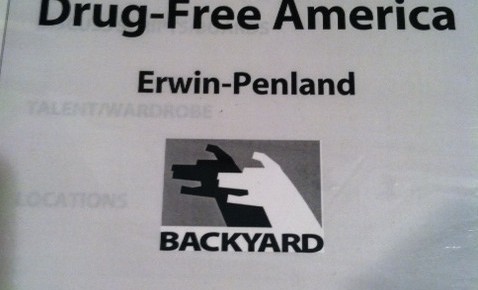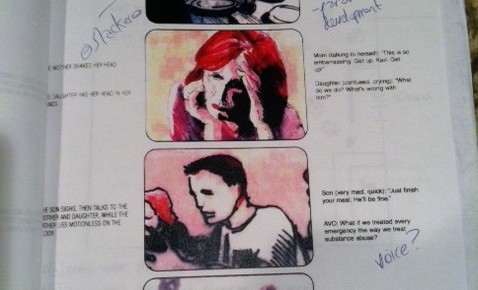How I Screwed Up a $300,000 TV Advertising Shoot

This is a post about failure. Not catastrophic, here’s-you-pink-slip kind of failure, but a see-your-15-minutes-of-fame-go-in-flames kind of failure. I’m going to show you how my team’s Partnership For a Drug-Free America TV idea beat out other, much larger agency’s ideas, then won the hearts of the client, then got shot in Los Angeles, then died. And I’ll show you how you can keep your ideas from dying.
THE INTERNAL PITCH
The Partnership for a Drug-Free America (PDFA) has an agency of record in New York. They’re big. They’re famous. And they’re kind of assholes when it comes to working with them on radio. (But that’s another story I’ll share.)
But every once in a while, PDFA will open up advertising opportunities to other agencies. Somehow, my agency got in…even though we were in Greenville, South Carolina. And once we got it, every creative lined up outside of our creative director’s office and put their name in the hat.
My art director partner and I were one of the teams. Now, some agencies won’t pit their teams against other internal teams, for fear of fighting. Hogwash. Let them fight. Why? Because it’s one thing to lose to another agency. Life goes on. But when you have the chance to lose against your own coworkers, you tend to work late. Every night. Every lunch. Every weekend. I’m not losing to the guy who drives a Porsche on floor 2.
Anyway, my partner and I pitched our ideas in front of the creative director, the strategy director, the owner and every single other creative team. But before we did, we picked the brains of the strategy guy.
Lesson 1: Pick the brains of your strategy team.
They’ve done the homework (presumably) and they know the client (you don’t). Better yet, I’ve seen ideas die a thousand deaths because the strategy team picked them apart like the movie Birds.
Lesson 2: Know your competition. Then un-sell them.
Was our idea the best one? Who knows. Maybe. It was on strategy and it was unique. But when we presented, we knew our competition. We knew a few teams would come with knee-slapping ideas and some teams would come with tear-jerkers. So when we presented, we talked about why we WOULDN’T proceed with high comedy or pure sadness.
See? We’re not only presenting our ideas, we’re killing the other ideas too. Devious.
THE TV SHOOT
Here’s the pre-production book. Or, as the nerds say: pre-pro book.
Fast-forward three weeks. We won. Obviously. We beat out other, much larger agencies because we nailed the strategy. (Once again, this does make a good spot, but, obviously, it helps open doors.)
We had our choice between two directors. One was heavy on design and macabre scenes (perfect). The other was a really, really good comedy director (not so good). Our concept wasn’t funny. It was uncomfortable, in a jarring way. (We hoped.)
You can guess what happened. The comedy director got the job. So during our pre-production conference calls and meetings, we highlighted how to bring this “jarring” concept to life. There were no red flags, but what I would have done differently is discussing alternate directions.
Lesson 3: Plan for the worst-case scenario.
During our pre-pro meetings, everyone agreed. Everyone shook hands. Everyone was happy. I even took notes, of which “parallel development” should have been a sign that I was an idiot.
Listen, I was four years into my career, on my very first TV shoot, so I was young and nervous. Same with my art director partner, who is brilliant. But he and I privately wondered if the “jarring” scenes were jarring enough. We thought so, but we trusted our executive creative director, our senior producer, the director and the LA producer. We were wrong. We should have spoken up and asked more questions.
Shoot day. Everything for the PDFA is donated (time, food, locations, etc), but nothing is spared. Video Village. Big-time actors. Craft services. The whole she-bang. This is a $300,000 shoot.
This is how you know it’s a big shoot. Multiple camera angles. Kidding.
The shoot goes well. The actors nail it. The director changes angles. The A/C is too loud, so we turn it off and everyone starts sweating. Oh well. Quit whining.
But towards the end of the shoot, my partner and I wonder if the main lines are too stale. Should we push them farther? Should we make them more absurd? What if we did a few outtakes?
We asked our executive creative director and he said, no, we’re fine. Just keep rolling. Finally, the director walked in and asked if we needed anything else. Inside, I screamed. Outside, I kept my stupid mouth shut. I wanted to do some alternate takes with really absurd lines. But I didn’t say anything.
You know what I was doing instead? I was sipping on a green tea smoothie. I swear to God.
Read that again: My career could have been drastically different because of a green tea smoothie.
Lesson 4: Go with your gut. No matter how “green” you are. And screw those green tea smoothies.
THE EDITING
As the first few edits rolled in from the West Coast, we knew something was wrong. Everything looked beautiful, the actors were great, the angles were great, but there was no “jarring” moment. There was no uncomfortable moment that makes the viewer think or act. But damn. If one or two of lines had been a bit more aggressive, I bet it would have worked. The director tried new edits. We tried new edits. Conference calls got heated. The client got mad. The director got mad. We slumped down in our chairs.
Lesson 6: I’m an idiot.
THE TESTING
The TV spot ran in Nashville and Atlanta and Los Angeles. Then it was tested. It did fine. But “fine” doesn’t get your TV spot added to the PDFA national rotation. So my mom never saw it on TV. Bummer.
Months went by. We entered the spot in the local Addy Awards. We lost to a spot about a dog in a hot air balloon, which was shot for $500. Congrats!
HOW YOU CAN NOT SCREW UP LIKE I DID
These lessons don’t just pertain to fancy TV spots. They work for eblasts, digital ads and crappy newsletters. Here’s a recap.
Pick the brains of your strategy team.
Do your homework. Read the brief. You don’t know everything. This has nothing to do with ass-kissing. Ask the right questions, fight the brief if you think it’s necessary, but don’t half-ass it and guess.
Know your competition.
If your competition is external, read their marketing materials. If they are internal, read their diaries.
[Tweet “If your competition is external, read their marketing materials. If they’re internal, read their diaries.”]
Plan for the worst-case scenario.
If you’re presenting, have back-ups and rationale. If you’re shooting or editing, have other ideas and alternate takes. Especially for TV, video and radio. Some of the greatest ideas in advertising and entertainment were adlibs.
Go with your gut.
If you’re thinking it, say it. Unless it’s stupid. Then say it anyway and apologize afterwards.
Screw green tea smoothies.
Never forget this lesson.
Don’t be an idiot.
Since this debacle, I’ve won a few national awards and an Obie, so I kinda learned my lesson. But I still screw up every day. By definition, approximately 90% of all advertising ideas die. That’s just the business. Email me or post a comment if you have questions regarding my idiocy or advertising in general.




